what to do after a hoof abscess bursts
Please notation: If you have any concern over your horse'southward health delight talk to your veterinarian in the first case. This commodity is designed for educational activity purposes rather than attempting to diagnose illnesses or prescribe treatment protocols.
What is an abscess?
A hoof abscess (pododermatitis purulenta) is a, unremarkably, localised pus filled (purulent) infection that forms between the dermis and the epidermis of the hoof (the squidgy bit and the hard horn), a scientific definition would be a purulent dermal inflammation of the podotrochlear apparatus.
Why did my equus caballus get an abscess?
An abscess needs ii things to form, leaner and a claret supply. The leaner will enter the hoof capsule either through a weakness, such every bit stretched white line or seedy toe, or through injection following a puncture wound. The blood comes from the damaged (bruised/leaky walls) blood supply of the dermis, usually either of the wall or the sole. Once the bacteria has met the blood supply, the torso volition observe the invasion of the foreign matter and will activate it's defense force mechanisms – specific types of white claret cells called lymphocytes multiply and produce antibodies to fight the infection, this is a standard allowed response and is the reason for the white pus in spots and abscesses.
Things differ in the hoof from other parts of the torso where this allowed response occurs in a couple of ways:
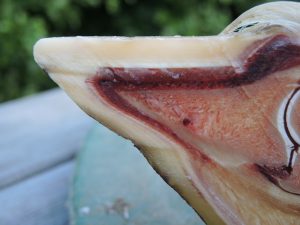
The "skin" of the hoof is the difficult horn casing, surrounding the soft dermis inside.
- The structure of the hoof – Because the hoof is mainly hard horn rather than soft tissue, any increase in pressure from multiplying lymphocytes is going to crusade hurting, this makes united states of america want (and need from a welfare point of view) to reduce the hurting as quickly equally possible.
- The way hooves grow – Sole and hoof wall are hard horn structures, that abound from soft fleshy structures – this happens by a process of keratinisation. As new cells course at the dermis, they push button slightly older cells towards the surface, these cells change shape as they are pushed outwards and gradually thin and flatten. This process is the same for all epithelial (skin) cells in all animals, where the hoof differs is that as the cells flatten, they also harden (keratinise) to form the horn that we run into on the outside. This is the key deviation with hoof abscesses to other skin abscesses, because the keratinising cells grade a pocket around the infection and within a brusque period of time, seal it off from the blood supply of the dermis – effectively preventing any further antibodies from reaching the infection, merely also preventing the infection from penetrating farther into the body*.
And then, nosotros take big amounts of pressure edifice upwards, but we too have a self limiting system that is sealed off from the remainder of the body.
* unremarkably – there are occasions when this procedure fails, see "what can go wrong" below
What should I practice side by side?
If we can encourage weight begetting and natural, unforced move on the affected foot (i.e. out in the paddock grazing, or in an enclosed yard), the abscess will bear much like a worked spot on a teenager'south face, it will follow the lines of least resistance and make its style out of the hoof, usually at the coronary band, either to a higher place the hoof wall, or at the heel bulbs, occasionally it will popular out under a bar or in one of the collateral grooves.
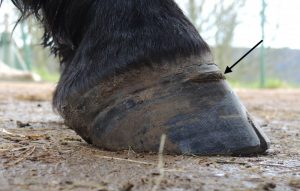
Typical abscess flare-up pigsty growing out (shown by arrow).
It does this because of the layer structure of the hoof, it is easier to move along the sole or up through the laminae than information technology is to work it'due south style down towards the footing at the whiteline. The flexion of the hoof capsule at every stride also helps this.
The groovy thing about nature's way of dealing with the abscess is that the hoof seals itself behind the moving abscess via the keratinisation process, and so the dermis is not at adventure of infection when the abscess bursts out. The central here though is reducing pain and encouraging movement. Some vets volition provide NSAIDS for a suspected abscess while others will want to intervene and instigate drainage at the beginning opportunity, equally this generally provides instant hurting relief, simply may accept complications (see below). Some of the herbal remedies available in tack and feed shops that contain Boswellia or Devil's claw tin be very helpful in improving comfort, the key thing is that it is of import from a welfare point of view not to get out the equus caballus hobbling around in hurting.
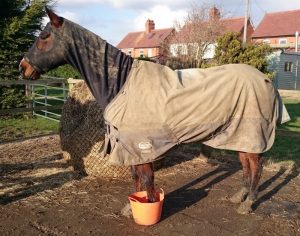
Later on a few days, many horses come to take and fifty-fifty welcome the hot tubbing procedure.
Many people recommend "hot tubbing" (soaking the foot in a bathroom of warm h2o with epsom salts) to soften the hoof and "draw" the abscess. Poulticing the human foot is also common for the same purpose. I'm not sure whether any studies take been done showing the efficacy of either intervention, only both make us experience better, and hot tubbing followed by hot poulticing may encourage the abscess to "mash" which volition increment the pressure and encourage mobilisation of the abscess through the foot. The tubbing procedure does seem to exist soothing, many horses that react to tubbing on the starting time occasion seem to be looking forward to it on solar day two and iii, and then is useful from that betoken of view. The poultice as well provides cushioning from the ground then may be more comfortable, peculiarly if the foot is and then protected with a hoof kick, the poultice is also useful to catch annihilation comes out from around the frog and confined if the abscess doesn't flare-up at the coronary band.
In a barefoot horse, with adequate pain relief and skillful mobility (not on box residual), y'all can look to see an abscess exit hole in 3-5 days, though some seem to rumble on for up to a calendar week or more.
What can go incorrect?
In that location are a few things that might go incorrect with the abscess recovery process:
- One is where drainage is established too quickly, before the dermis has had a chance to seal itself from the infection, this can pb to recurrent infections over a catamenia of several weeks, or months if yous are actually unfortunate.
Another problem is when the internal structures of the hoof are already damaged, such every bit in a example of laminitis or pedalosteitis, and the dermis is unable to grow new cells fast enough to seal off the abscess. In this case, the infection can rail back into the body, leading to filled legs, this is dangerous for the horse and a vet is needed quickly to provide antibiotics to control the infection. -
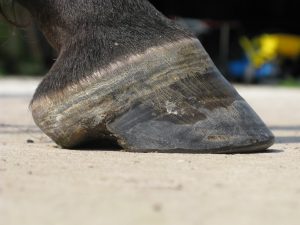
Less than 4 months subsequently, the heel has grown down and is fully weight begetting
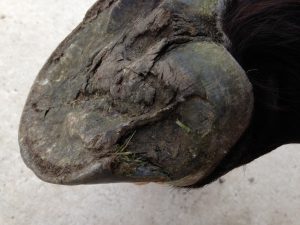
Abscess nearly the heel that acquired the whole heel to snap off, as you tin can meet, the internal structures are protected by keratinised horn.
The exit hole could exist in a location such as the heel area and may atomic number 82 to a big piece of heel wall snapping off. There are ways of mitigating this though, through the utilise of prosthetic devices on the hoof (shoe/hoof boot/poultice) which limit leverage and movement of the affected function. Notwithstanding, because of that magic sealing mechanism described earlier, you would accept to be very unlucky for the slice of wall falling off leading to farther infection.
- While it is unusual, sometimes isn't an abscess, but something else wrong with the foot – septic pedalosteitis, keratoma, canker, quittor, fractured pedal bone, penetrating wound etc. For this reason, it is of import to understand the progression of the lameness and involve your vet if you take whatever concerns that your lame pony has something other than an abscess.
(Kind thanks to Vikki Fear for donating this article.)
Source: https://www.epauk.org/about-equine-podiatry/articles/hoof-abscesses/
Post a Comment for "what to do after a hoof abscess bursts"